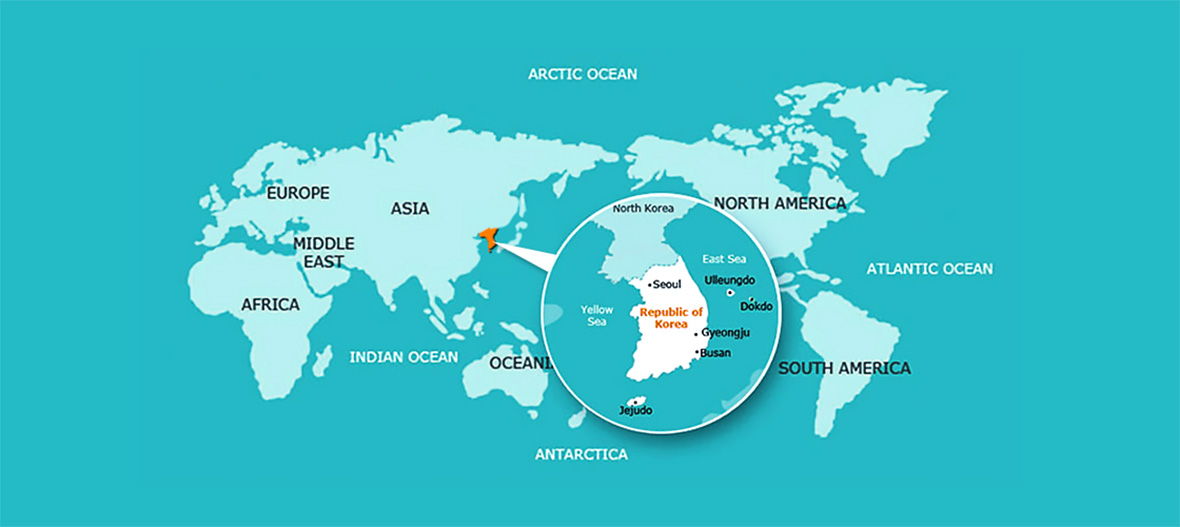The Republic of Korea (herein after Korea) is a country visited by approximately ten million international travelers every year. With its long history in culture and tradition, the country has a lot to offer to travelers. Continue reading to learn general information about Korea before visiting.

Where is Korea?
The Korean peninsula, roughly 1,030 km long and 175 km at its narrowest point, has a total land area of 100,033 km2 and is located in Northeast Asia. With Seoul as its capital city, Korea is neighbored by Japan to the east, China to the west and the Democratic People’s Republic of Korea (North Korea) across the northern border.
Culture
HANGEUL Korean Alphabet
Hangeul, one of the most unique creations of Korea, was introduced in 1443 by King Sejong, the 4th king of the Joseon dynasty. To help all commoners to easily read and write this alphabet, Hunminjeongeum (meaning ‘Proper sounds to instruct the people’ in Korean) was created. The UNESCO inscribed Hunminjeongeum Haerye; The Hangeul Manuscript, on the Memory of the World Register in 1997.
Koren Traditional Clothes HANBOK
Hanbok is the traditional attire of the Korean people. Worn daily up until just 100 years ago, hanbok comes in various shapes and colors, reflecting the culture and lifestyle of the its time. Nowadays, it is only worn on special occasions or anniversaries. The core of hanbok is its graceful shape and vibrant colors, which have had a major impact on the modern fashion industry.
HANSIK Korean Traditional Food
Hansik refers to traditional Korean food, centered on rice, served alongside a bowl of soup and a variety of side dishes. Most dishes use meat and vegetables as the main ingredients, boiled or steamed in brine or water rather than fried in oil, making hansik very healthy. Hansik's most outstanding feature is the fermented foods. The most well-known are kimchi (fermented cabbage).
Koren Pop Culture HALLYU
Korea has been risen not only in the field of technology and engineering, but also in the field of culture. Hallyu, which refers to the increase in popularity of Korean culture, has been expanded nationwide. Ranging in genres from K-pop to the larger Hallyu entertainment business and culture, Korea’s cultural influence has been increasing to Asia and to the world.
Culture
HANGEUL Korean Alphabet
Hangeul, one of the most unique creations of Korea, was introduced in 1443 by King Sejong, the 4th king of the Joseon dynasty. To help all commoners to easily read and write this alphabet, Hunminjeongeum (meaning ‘Proper sounds to instruct the people’ in Korean) was created. The UNESCO inscribed Hunminjeongeum Haerye; The Hangeul Manuscript, on the Memory of the World Register in 1997.
Koren Traditional Clothes HANBOK
Hanbok is the traditional attire of the Korean people. Worn daily up until just 100 years ago, hanbok comes in various shapes and colors, reflecting the culture and lifestyle of the its time. Nowadays, it is only worn on special occasions or anniversaries. The core of hanbok is its graceful shape and vibrant colors, which have had a major impact on the modern fashion industry.
HANSIK Korean Traditional Food
Hansik refers to traditional Korean food, centered on rice, served alongside a bowl of soup and a variety of side dishes. Most dishes use meat and vegetables as the main ingredients, boiled or steamed in brine or water rather than fried in oil, making hansik very healthy. Hansik's most outstanding feature is the fermented foods. The most well-known are kimchi (fermented cabbage).
Koren Pop Culture HALLYU
Korea has been risen not only in the field of technology and engineering, but also in the field of culture. Hallyu, which refers to the increase in popularity of Korean culture, has been expanded nationwide. Ranging in genres from K-pop to the larger Hallyu entertainment business and culture, Korea’s cultural influence has been increasing to Asia and to the world.
Travel Information
Time zone
The Republic of Korea is on Korea Standard Time (UTC +9:00) and does not observe daylight savings.
Climate
Korea enjoys four distinct seasons of spring, summer, autumn, and winter. July is the best season of the year, with perfect temperature and amazing natural scenery.
Electricity
The standard voltage in Korea is 220 volts at 60 Hertz, and the outlet has two round holes.
If you do not have a multi-voltage travel adapter, you may ask to borrow or purchase one from your hotel's front desk. You can also find them at the airport, retail stores, major duty-free shops, and even convenience stores.
Korean Currency
Korea's official monetary unit is the won.
For tourism information, please refer the following websites:






